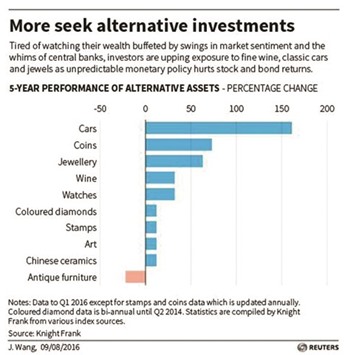Investment demand for gold hit record first-half levels this year, a World Gold Council report showed yesterday, fuelled by a push towards low and negative interest rates, and concerns over political issues such as Brexit.
Strength in investment offset a drop in jewellery purchases, especially among leading consumers China and India, to take overall first-half gold demand to the second highest on record, at 2,335 tonnes.
Investment in gold surged to 448 tonnes in the second quarter, more than double the figure for the same period of 2015, driven chiefly by a year-on-year rise in ETF investment to 236.8 tonnes, against outflows of 23 tonnes a year before.
Preliminary data showed those inflows continuing into the second half, with a further 80 tonnes added in July, the WGC’s head of market intelligence, Alistair Hewitt, said.”There are three structural factors prompting institutional investors to... increase their exposure to gold,” Hewitt told the Reuters Global Gold Forum yesterday.”The first is the unparalleled loosening of monetary policy, most notably the pernicious spread of negative interest rates,” he said.”Second, you have increasingly fractious politics, aptly illustrated by Brexit, and... finally the slowing pace of US interest rate hikes and consequent slowdown of US dollar strength.” Gold tends to benefit from ultra-low rates, which cut the opportunity cost of holding non-yielding bullion.
While ETF investment was strong, consumer buying of smaller retail products such as coins and bars was little changed at 211.6 tonnes, against 209.1 tonnes a year earlier.
The surge in investment helped fuel a 25% rally in gold prices in the first half.
Higher prices weighed on other areas of demand, leading investment to overtake jewellery buying as the largest single segment of demand for the first half-yearly period ever.
Jewellery buying fell 14% in the second quarter to 444.1 tonnes.
Jewellery demand in China, the world’s largest gold buyer in the last quarter, fell 15%, while offtake in number two consumer India slid by a fifth. “Steep price rises have done little to attract demand in the more price sensitive markets,” the WGC report said. “Indian consumers in particular are notoriously wary of price instability and this year has proven to be no exception.” Consumer demand in China overall fell 14% to 183.7 tonnes, well below the five-year average of 251.3 tonnes.
Poor consumer sentiment, a lacklustre economic backdrop and hallmarking regulations all weighed on demand, the WGC said.
Central bank demand fell 40% to 77 tonnes in the same second quarter.
Higher prices led to a 23% surge in gold recycling rates to 327.7 tonnes, however, which pushed overall gold supply 10 % higher.

.


